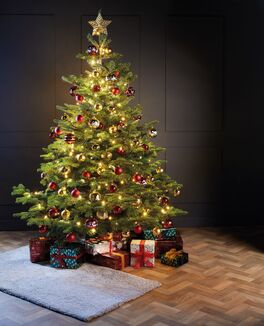
A green Christmas tree, decorated with lights and decorations.

A white Christmas tree, decorated with bronze baubles.
A Christmas tree is a decorative tree, used to celebrate the tradition of Christmas. It is typically an evergreen conifer like spruce, oak, or fir, or an artificial tree of a similar appearance, the same with the festival of Christmas, which originated in Germany with Saint Boniface. The tradition originated in mediaeval Livonia (today's Estonia and Latvia) and early modern Germany, where German Protestant Christians decorated their homes with trees. During the second half of the nineteenth century, it gained popularity outside of the Lutheran areas of Germany and the Baltic governorates, originally among the upper classes. Roses made of coloured paper, apples, wafers, tinsel, and sweetmeats were usually used to decorate the tree. With the arrival of electrification, Moravian Christians started to light candles to light Christmas trees, which were eventually replaced by Christmas lights. Garlands, baubles, tinsel, and candy canes are among the many traditional and new ornaments available today. To represent the Angel Gabriel or the Star of Bethlehem from the Nativity, an angel or star may be positioned at the top of the tree. Gingerbread, chocolate, and other sweets are also common, and are bound to or hanging from the tree's branches with ribbons. Christmas trees are displayed on various days in the Western Christian tradition, such as the first day of Advent or sometimes as late as Christmas Eve, depending on the country; similar faith customs hold that the two traditional days for removing Christmas decorations, such as the Christmas tree, are the Twelfth Night and, if not taken down on that day, Candlemas. In discussions of its folkloric roots, the Christmas tree is often compared to the 'Yule tree.'
History[]
The ancient Egyptians, Chinese, and Hebrews all used evergreen trees, wreaths, and garlands to symbolise everlasting life. Tree worship was widespread among pagan Europeans, and it was preserved in Scandinavian traditions such as decorating the house and barn with evergreens at the New Year to ward off the Devil, and putting up a tree for the birds during the Christmas season. It persisted in the tradition of planting a Yule tree at an entrance or inside the house during the midwinter holidays, which is often practised in Germany.
By the 18th century, the practise had spread to German Lutherans, but it was not until the next century that the Christmas tree became a deeply entrenched German tradition. The Christmas tree was first introduced to England in the early nineteenth century, but it was popularised in the mid-nineteenth century by German-born Prince Albert, Queen Victoria's husband. Toys and small presents, candles, candies, popcorn strings, and fancy cakes were suspended from the branches of the Victorian tree by ribbons and paper chains. Christmas trees were brought to North America by German immigrants as early as the 17th century, and by the 19th century, they were all the rage. Austria, Switzerland, Poland, and the Netherlands were all particularly fond. Christmas trees were adorned with elaborate paper patterns in China and Japan after being adopted by Western missionaries in the 19th and 20th centuries.
| Christmas |
|---|
